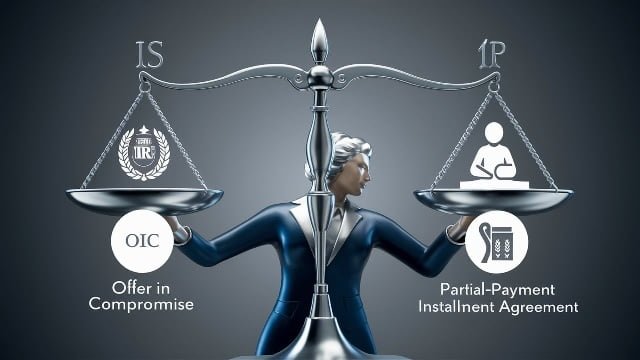Imagine you’re dealing with a pile of overdue tax notices and feeling the weight of IRS debt. This situation is more common than you might think.
In 2022, many taxpayers found themselves in similar circumstances and sought relief through offers in compromise, proposing to settle tax debts for less than the full amount owed. Out of 36,022 offers made, the IRS accepted 13,165, leading to settlements amounting to more than $234.3 million. This shows there are ways and help available for people with tax problems to get past their money troubles.
The Offer in Compromise (OIC) program might be your way out. It allows individuals to settle their tax debts for less than the total amount owed. While it may seem unlikely, with the right guidance, it’s a viable option.
Professional CPA services, like ours in Florida and beyond, are crucial when considering an OIC. Our experts specialize in developing strategies for offers in compromise, among other tax relief solutions. Continue reading to learn how you can confidently manage your IRS tax debt with careful planning and professional assistance.
What is an Offer in Compromise?
An Offer in Compromise (OIC) allows you to settle your tax debt for less than the full amount you owe. This can be a viable option if paying your full tax liability would cause financial hardship. The IRS considers your ability to pay, income, expenses, and asset equity to determine whether to accept an offer.
To ensure you’re making the best choice, it’s essential to review all available payment solutions before opting for an OIC. Let’s move forward by understanding the eligibility criteria to see if an OIC is the right path for you.
Eligibility for Offer in Compromise
Before applying for an OIC, ensure that you meet the following criteria:
- All required tax returns have been filed, and all required estimated payments have been made.
- You are not currently in an open bankruptcy proceeding.
- You have a valid extension for a current year’s return if you apply for the current year.
- If you are an employer, you have made tax deposits for the past two quarters.
What happens if you are not eligible?
If the IRS finds you ineligible after applying:
- The IRS will return your application and offer an application fee.
- Any offer payment you make will be applied to your tax balance due.
How to apply for an Offer in Compromise?
Here’s how to complete your Offer in Compromise application, broken down into simple steps:
Gather your financial information
- List all your assets, like cash, investments, property, and debts.
- Calculate your family’s total monthly income and expenses.
- Note: Expenses like private school fees or unsecured debts typically aren’t considered by the IRS.
Complete Form 433-A (OIC) or 433-B (OIC)
- Use Form 433-A (OIC) if you’re an individual or self-employed. It helps the IRS understand your financial situation to assess your ability to repay your tax debt
- Married but separated? Each spouse needs to fill out their form.
- Use Form 433-B (OIC) for business-related debts. It gathers details about your business finances to determine a suitable offer amount for settling your business tax debt.
- These forms help determine a suitable offer based on your financial situation.
Attach the required documents
- Include all the necessary documents listed at the end of Forms 433-A (OIC) and 433-B (OIC).
- Only send copies, not the original documents.
Fill out Form 656
Form 656 is the official IRS form you use to submit an Offer in Compromise (OIC). Essentially, it’s your written proposal to settle your tax debt for less than the full amount you owe. The completed form will specify the taxes you’re offering to settle and the amount you’re proposing to pay.
- List the taxes you’re offering to settle.
- Your offer amount should be equal to or greater than the value assessed in Forms 433-A or 433-B.
Include your initial payment and application fee
- Attach your initial offer payment and a $205 application fee.
- If making a lump-sum offer, include 20% of the total offer amount.
- For a payment plan, including the first month’s installment.
- Checks or money orders should be made out to “United States Treasury.”
- If you qualify for Low-Income certification, skip this step.
Mail your application package
- Make a copy of all documents for your records.
- Send the original documents to the IRS address provided in the application checklist.
- If you’re in contact with an IRS representative, inform them that you’re submitting an Offer in Compromise.
How to Pay the IRS?
When you suggest a deal to the IRS to pay less than your total tax debt, you must decide how to start making payments:
- Lump Sum Cash Payment:
- You need to pay 20% of your total offer amount upfront with your application.
- If the IRS accepts your offer, you need to pay the remaining amount in five or fewer payments within five months after they accept.
- Periodic Payment:
- Start with your first payment along with your application.
- Then, continue to pay the rest in monthly installments over 6 to 24 months, according to what you proposed in your offer.
- Keep making these monthly payments while the IRS reviews your offer. If you stop payments before they decide, they might reject your offer without a chance to appeal.
- Your total payments should add up to the entire offer amount.
Note for Low-Income Applicants
- If you meet the Low-Income Certification guidelines, you don’t need to make the initial or monthly payments while your offer is being reviewed.
- After your offer is accepted, you’ll have to start payments 30 days after the acceptance or another agreed-upon time.
What if you can’t pay an upfront payment?
- Consider borrowing money from a bank, friends, or family if you don’t have enough cash.
- You might also look into selling some assets or borrowing against them to come up with the money for your offer.
Offer in Compromise Review Process, IRS
While the IRS reviews your offer:
- Payments and fees are applied to the tax liability.
- Collection activities may be suspended, but a Notice of Federal Tax Lien may be filed.
- Legal assessment and collection periods are extended.
- If your offer is automatically accepted, the IRS does not determine within two years.
What happens when your OIC is approved?
Upon acceptance, you must:
- Adhere to all offer terms, including filing all required tax returns and making all payments.
- Understand that federal tax liens are not released until you satisfy the offer terms.
What happens when your OIC is rejected?
You can appeal the decision within 30 days using Form 13711. The IRS Independent Office of Appeals can provide additional assistance.
Form 13711 is your appeal form if the IRS rejects your Offer in Compromise (OIC) application. If you disagree with their decision, you can use this form to formally request a review by the IRS Independent Office of Appeals. This form allows you to explain why you believe the rejection was wrong and provides an opportunity to potentially get your OIC application reconsidered.
Alternative Solutions to Tax Debt
In dealing with tax debts, the IRS provides several options beyond the Offer in Compromise to help individuals settle their dues. Here are some of the common solutions:
- IRS Wage Garnishment: A legal process where the IRS demands an employer to withhold a portion of the taxpayer’s earnings to cover unpaid tax debts.
- Installment Agreement: Allows taxpayers to make monthly payments towards their debt if they cannot pay the full amount at once.
- Currently Not Collectible Status: If the IRS determines a taxpayer cannot afford to pay any of their tax debt due to financial hardship, they may declare the debt Currently Not Collectible, halting collection actions temporarily.
- Penalty Abatement: This involves the reduction or removal of penalties for taxpayers who have a reasonable cause for failing to comply with tax laws.
- Innocent Spouse Relief: Provides relief from additional tax owed if a spouse or former spouse failed to report income, reported income improperly, or claimed improper deductions or credits.
- Streamlined Installment Agreements: For taxpayers owing $50,000 or less, this option allows for the setting up of a payment plan without full financial disclosure.
- Partial Payment Installment Agreement: Allows taxpayers to make smaller monthly payments towards their tax debt, which may not cover the full amount owed before the time to collect the debt expires.
These options are intended to help individuals manage and resolve their outstanding tax liabilities with the IRS in a manageable way.
End Note!
A complete application is essential for a successful negotiation of an Offer in Compromise (OIC) with the IRS. Many applications are turned back because they’re missing important parts, like specific forms and documents. For eligibility, you mustn’t be in bankruptcy, have all relevant tax returns filed, be up-to-date with payroll taxes for the last two quarters, pay a $205 application fee, submit the right forms (656, 433-A, and/or 433-B), and keep current with your estimated taxes and withholdings for the year.
But if you are in this situation, we have solutions to overcome, pay the proposed offer amount, file all tax returns promptly, let the IRS apply any refunds or credits towards your debt, and even after your OIC is approved, continue to allow the IRS to use any future refunds to lower your tax liabilities.
Finally, considering the tough situation of an OIC, it’s wise to work with a tax professional who knows the ins and outs of the process. Choose us, as we are experienced in tax law and familiar with OIC requirements to guide you through, ensuring you meet all the necessary criteria without missing a step.






